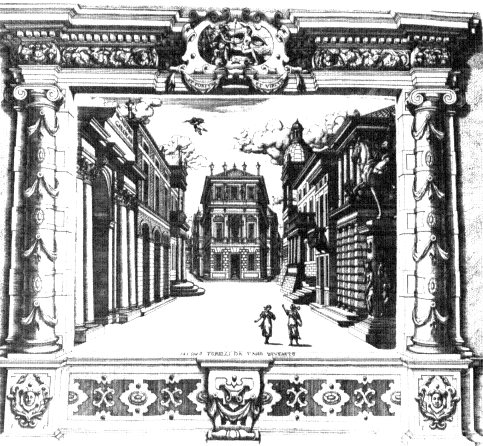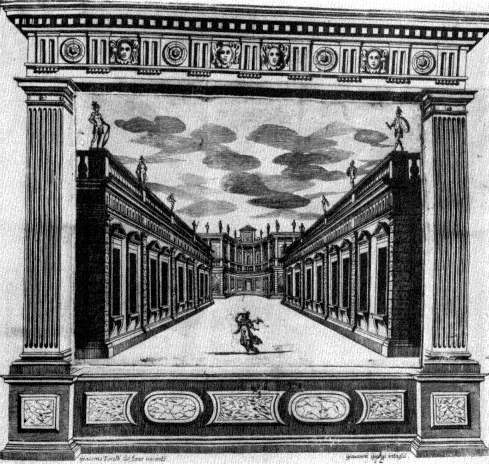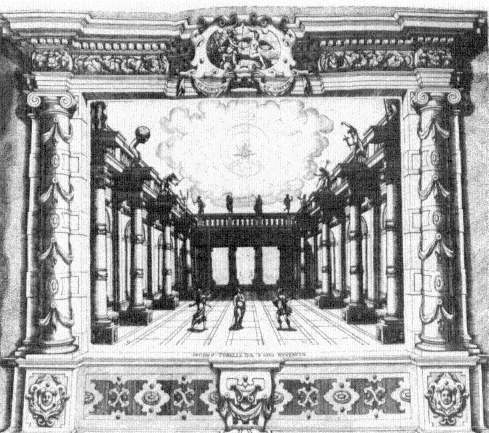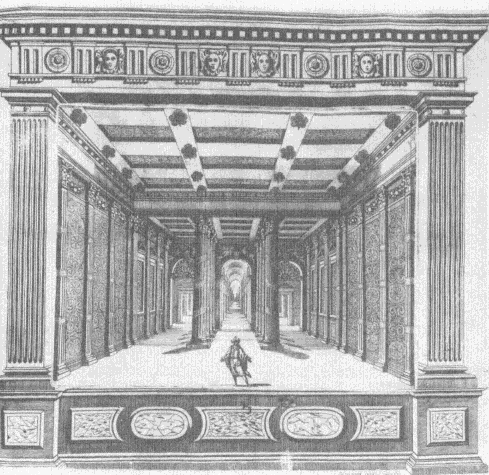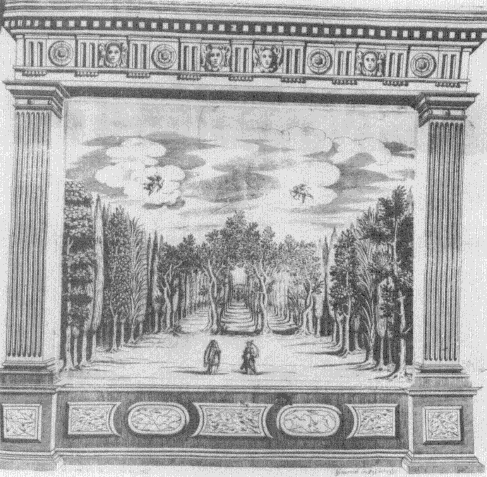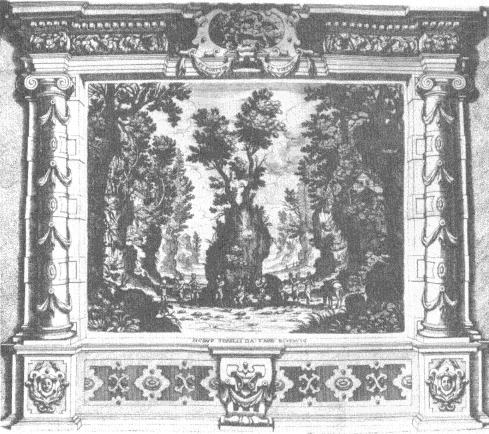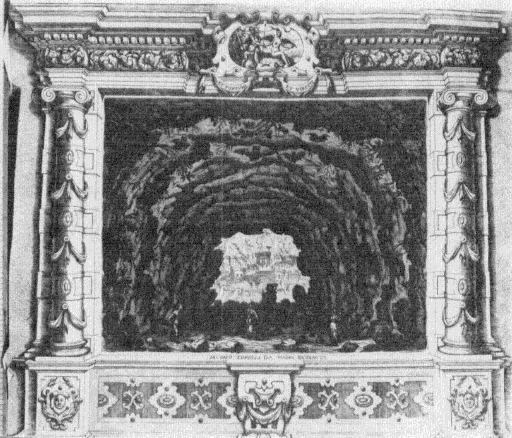Making Histories
Bissari was neither the first nor the last to identify the problem.[4] From its very beginnings, opera in Venice had been marked by an intense awareness of itself and a determined effort to create a pedigree. This is evident in the tendency toward obsessive record-keeping that had characterized—even justified—the earliest Venetian librettos. Thus, the printer's preface to Ferrari's La maga fulminata , the second Venetian opera, referred to its only predecessor, the already legendary Andromeda , presumably as a means of sharing in its success (Appendix I.3b). And both of them were invoked in the preface to the third Venetian opera, Delia , by Strozzi, who, in homage to Ferrari, as we have seen, even borrowed a character from La maga fulminata , the witch Scarabea. Strozzi continued to keep records in his subsequent works, introducing his next libretto, La finta pazza , as his eighth "fatica rappresentativa," and mentioning both it and its two successors, La finta savia (1643) and Romolo e Remo (1645), in the preface to the former.[5] Not only in the prefaces, but in the texts of librettos themselves, opera's progress was being charted. As we are reminded by Armonia, a char-
acter in the prologue of Faustini's Ormindo (1644): "It has been five years already that I have shone on you from gilded stages and displayed my glories."[6]
Audiences could not fail to notice, since it was pointed out so regularly to them, that opera was getting on, was being engulfed by its own history. And they were becoming jaded, bored; they wanted novelty, and they wanted it often. Their demands placed a heavy burden on the creators of opera, who developed various strategies of response. In search of fresh plots, librettists reached out to new sources and new literary models, beyond mythology, Greek and Roman history, romance, and the pastoral to the more exotic history of the Near East and the more domestic novella .[7] Furthermore, they treated all of their sources with increasing freedom, adding an ever greater proportion of invenzione . In 1643 Busenello had briefly recounted Tacitus's version of the Poppaea story only to depart from it, concluding with laconic frankness: "But here things will be represented differently" ("Mù qui si rappresenta il fatto diverso"). Twelve years later, however, in the preface to Statira , he does not even bother to outline a historical version of the plot, declaring that only the names of the characters—but not their relationships—were borrowed from classical history.[8] Busenello's younger contemporary Castoreo stated the case for invenzione even more explicitly in the preface to his Pericle effeminato (1653):
If you find something in it connected with history, know that the rest is pure invention, and therefore you will be wasting your time if you go and sift through Plutarch and Thucydides to find out whether I have strayed from the truth; because my intention is not to report a history to you but to present a tale that has nothing historical in it besides its name. It is indeed true that its principal plot is drawn from Plutarch, who writes about the passions of Pericles and Aspasia, through which he acquired the epithet effeminate; nevertheless, in fitting them into this drama I have followed my own fancy. (Appendix I.40a)
In addition to reaching out to new sources, librettists turned their attention inward, on their own art, exploiting its already established conventions with ever greater energy. Along with composers and stage designers, they found essential materials in the already proven successes of the past. Increasingly, librettos that had been used before, either in Venice or elsewhere, were revised for new Venetian performances. Usually these needed to be adapted to their
new contexts—either modernized to suit the taste of the times or Venetianized ("Riformato all'uso di Venetia").[9] During the early 1650s there were several such revisions. Veremonda , by Luigi Zorsisto [Giulio Strozzi], which was performed with Cavalli's music at the Teatro SS. Giovanni e Paolo in 1653, was a doubly revised work. Not only was it imported from Naples, where it had been performed in Cavalli's setting the previous year, but it was a reworking of an earlier libretto by Cicognini, Celio , that had appeared in Florence in 1646.[10] Another Neapolitan libretto, Ciro (1653), by Giulio Cesare Sorrentino, was altered for Venetian use ("con prologo, aggiunte, imitationi, & aggiustamenti all'uso di questa città") by an unnamed poet and performed at SS. Giovanni e Paolo in 1654. In this case, Cavalli merely retouched the original score by Francesco Provenzale.[11] Adaptation became so common during the 1660s that it could be invoked falsely to mask the original authorship of a work if necessary. For some reason Minato passed off his Seleuco of 1666 as the revision of an anonymous Neapolitan work, though he acknowledged his authorship at a subsequent revival.[12]
While some such adaptations were completely straightforward and aboveboard, giving due credit to the original author, others went unacknowledged, masking themselves as original works. Aureli, for example, based an entire libretto, Erismena (1655), on Faustini's Ormindo (1644), even appropriating the text of one of its most striking moments, the prison scene.[13] In fact, this kind of unacknowledged modeling must have been quite common, since librettists
often took elaborate pains to deny it—or used it as a subterfuge. One scene was cut from Faustini's Eritrea (1652) ostensibly because it had been used elsewhere: "The elephant scene, which Your Illustrious Lordship will observe [is] mentioned, and which was the invention of the poet, has been left out because it does not suit a queen's dignity to wear clothes that, although intended for her, have been worn first by someone else" (Appendix I.35b).[14] And, only a few years later, Castoreo defended himself against plagiarism in La guerriera spartana (1654): "There were some who accused [the warrior] of theft because they noticed on the hem of one of her dresses a certain decoration that seemed woven at the same loom as someone else's; but let it not even be mentioned, because I could thoroughly defend it should there be need" (Appendix I.41).[15]
Along with the wholesale adaptation of old texts, librettists also appropriated and rearranged more circumscribed material from earlier librettos: scene types, dramatic procedures, and so on. Much of this material belonged to the common stock available to any potential librettist, a body of conventions in part borrowed from spoken drama, in part established by repeated use in operatic works. In most cases the reuse of such material was generalized and natural, but in some it was more specific and can qualify as outright borrowing. Such borrowing was sometimes explicit: we have seen how Faustini acknowledged lifting an episode of madness for his Egisto (1643), although he did not name his source (Appendix I.31a). Librettists apparently had to be careful that their borrowings were generic enough not to arouse suspicion; but as these were the very stuff of their trade, they could hardly avoid them altogether. They had to strike a balance between convention and novelty: convention enabled librettists to construct their works quickly and made them easily accessible to their audience; novelty added the spice of variety that attracted special attention.
Just as librettists relied increasingly on the adaptation of older texts, so the composer's role was frequently limited to the reworking of another composer's score to adapt it to a new set of performing conditions (as in Ciro mentioned above). And they too made increasing use of previously composed music—individual arias or even, as in the case of Erismena , whole scenes. Composers adapted to the pressures of increased demand in other ways as well. Their response, to be discussed at length in the next several chapters, is manifested by a decrease in their impact on the shaping of librettos. This in turn was balanced by greater reliance on conventional formulae for setting individual poetic structures as well as dramatic situations.
The balance of convention and novelty presented a special problem in the realm of scene design. The situation was complicated by the overwhelming stature of one scenographer in particular, Giacomo Torelli. Although he himself left Venice for good by 1645, he remained a looming presence for many years, having made an indelible impression on the very conception of Venetian opera. It was difficult to match Torelli's achievement, let alone surpass it. Bissari confirmed Torelli's position in the preface to Yorilda (1648) by describing the effects of opera in the precise terms of his achievement: "Among the most often remarked upon curiosities of the modern dramas is the diversity of sets, which, pulled around or guided along wooden channels by a machine that changes them in an instant, open up new views everywhere" (Appendix I.25a).[16] Variety and speed of execution were among the chief marvels of Torelli's technique; but he was also widely praised for the verisimilitude and sheer extravagance of his conceptions.
At least one opera was specifically designed to meet the challenge of Torelli head on. In Bradamante (Bissari/?Cavalli, 1650), an extraneous character ("personaggio accidentale") is introduced for the express purpose of enhancing the spectacle: Bellerofonte, mounted on Pegasus, attempts to obstruct Astolfo's moonward journey on the hippogriff, but fails, falling to earth in ignominious defeat—and in a triumph of stagecraft. This "caduta di Bellerofonte," created by the scenographer Giovanni Burnacini, makes a direct (scenic) reference to Torelli's notorious and much publicized similar achievement in Bellerofonte several years before.[17]
Economic considerations must have affected scenography more than any other component of opera. The level of financial support that Torelli had so briefly enjoyed at the Teatro Novissimo was not easily matched elsewhere; even the queen of France had balked at the expenses incurred for La finta pazza in Paris.[18] Physical resources were obviously as necessary for scenic spectacle as financial ones, for the productions at two of the smaller Venetian theaters, S. Moisè and S. Apollinare, were regularly berated (by their own creators) for the inadequacy of their spectacle.[19]
Since it was so difficult to surpass Torelli's accomplishment, scenographers, even more obviously than their librettist and composer colleagues, tended to
make use of conventional formulas; they borrowed and rearranged old materials. Indeed, most operas after 1650 called for a rather standard group of sets or scene types that could be reused and easily adapted to successive productions: a city, a royal palace, a courtyard, a chamber, a garden, a wood, a hellmouth (figs. 17-23).[20]
Some of the most striking scenic effects after 1650 occurred in prologues—in that of Ciro (1654), for example (apparently a highly effective prologue, since it was used subsequently for other works as well).[21] Architecture asserts her superiority over Poetry and Music in Ciro by making a spectacle of her own deconstruction, falling apart in full view of the audience, and she creates a similar spectacle of herself in the prologue to Veremonda (Naples, 1652).[22] Prologues, the traditional locus of aesthetic commentary from the author, were readily detached from the drama. Thus, if it were concentrated there, extravagant scenography could easily be eliminated if sufficient funds or equipment were unavailable. Despite an increased reliance on convention and the relegation of many of the most striking scenographic effects to detachable prologues after 1650, most observers continued to be struck by the visual marvels of opera for the remainder of the century.[23]
One of the most far-reaching consequences of the institutionalization of opera in the 1650s has yet to be mentioned. The needs created by intensifying
17.
Giacomo Torelli, stage set for Venere gelosa (1643), 2.1-7: Città di Nasso.
Engraving from Apparati scenici (Venice, 1644).
commercial activity, with the attendant promise of financial reward, brought into being a new kind of professional, the poet who devoted himself exclusively, willingly, and even proudly to dramma per musica : the librettist. We have been talking about librettists, operatic poets, all along, of course, about the various members of the Accademia degli Incogniti and about Ferrari, but in fact, until the middle of the century the authors of operatic texts were either more or less than librettists. Ferrari was librettist, composer, performer, and impresario all in one. An old-fashioned "theater man" in the style of his near contemporary Giovanni Battista Andreini, who led his own troupe of comici ,
18.
Giacomo Torelli, stage set for Bellerofonte (1642), 1.4-10: Regio cortile.
Engraving by Giovanni Giorgi.
and wrote and starred in his own plays, Ferrari embodies the essential link between commedia dell'arte and opera.[24]
The talents of his chief competitor among the early operatic poets, Strozzi, were more exclusively literary. But even then, libretto-writing was only one
19.
Giacomo Torelli, stage set for Venere gelosa (1643), 2.10-3.4: Cortile del Re di Nasso.
Engraving from Apparati scenici (Venice, 1644).
facet of Strozzi's literary activities; he also wrote plays, poetry both epic and lyric, and history. The same was true, of course, of Strozzi's Incognito colleagues, who claimed to have become librettists in spite of themselves. I have already remarked upon their disinclination to admit involvement in libretto-writing, their disguising of their own authorship by means of standard seicento obfuscation: pseudonyms, allusions, anonymity. Even when they did confess, they were usually apologetic, explaining their librettistic activity as the result of some extenuating circumstance or gratuitous act.
Debts of friendship were often cited as an excuse. Pietro Michele, the "Incognito" author of Amore innamorato , had apparently agreed to write the libretto out of friendship for Loredan but refused to have anything further to do with
20.
Giacomo Torelli, stage set for Bellerofonte (1642), 3.8-12: Sala regia.
Engraving by Giovanni Giorgi.
it, lacking the inclination "di buffoneggiare ne i Theatri."[25] The anonymous author of Argiope (1649), too, though a famous poet, needed the encouragement of friends in order to undertake writing the libretto; this according to Fusconi's preface:
21.
Giacomo Torelli, stage set for Bellerofonte (1642), 3.1-7: Boschetto del giardino reale.
Engraving by Giovanni Giorgi.
The fabric of this tale results from the pleas of friends, dashed off rather than woven, in fourteen evenings, by the pen of that most famous swan of the Adriatic, who keeps Italian poetry alive in our century. Since he was on the verge of departure, and awaiting favorable winds for a long sea voyage, he could not apply himself to it except at moments stolen from sleep. (Appendix I.28b)[26]
22.
Giacomo Torelli, stage set for Venere gelosa (1643), 3.6-10: Campagna di Nasso.
Engraving from Apparati scenici (Venice, 1644).
What sprezzatura : to knock off a libretto in fourteen sleepless nights, just to please friends. Friendship evidently could force even non-poets to try their hand; and if their work was criticized, they could always blame the music.[27]
23.
Giacomo Torelli, stage set for Venere gelosa (1643), 2.8-9: Inferno.
Engraving from Apparati scenici (Venice, 1644).
Many of these authors claimed amateur status, insisting that they had written librettos merely to while away their idle hours or to ward off boredom. As Badoaro wrote (anonymously) in the preface to Il ritorno d'Ulisse : "the world knows that my pen fights to defeat boredom, and not to earn glory" (Appendix I.7b). In the same vein, Busenello called his published (1656) collection of librettos Le hore ociose (The Idle Hours ). A few writers even used illness as an excuse, both for having indulged in libretto-writing at all and for whatever shortcomings might be found in their works.[28]
Even Minato, who was to become one of the most successful of all Venetian librettists, began his career by belittling his own theatrical efforts, asserting his greater commitment to his real profession, the law, and claiming that he had written his dramas during time he would otherwise have spent sleeping: "Know that I am not a poet. . . . My vocation is in the Forum; to serve him who can command me, I have stolen a few hours from sleep in order to devote them to this drama. I swear to you that the sun has never seen me with pen in hand to form characters in ink."[29]
In the same self-deprecating tone, several authors modestly insisted that they composed not for fame or riches but "per mero capriccio." The first writer actually to use the expression may have been Francesco Melosio, in the preface to Sidonio e Dorisbe (1642): "Be satisfied with knowing that I write out of mere whim, and that I do not want to bind myself to the strict observance of the rules."[30] The most notorious declaration of these sentiments, however, came from the pen of Giacinto Andrea Cicognini, in the preface to Giasone (1649): "I write out of mere whim; my whim has no other aim than to give pleasure. To bring pleasure to myself is nothing other than to accommodate the inclination and taste of those who listen or read."[31]
Cicognini's statement raises once again the issue of il diletto versus l'utile that had concerned the earlier, academic librettists. But that issue now had a new twist. Melosio, who, like the academics, was suffering the pangs of generic insecurity that characterized the early 1640s, used the phrase primarily to absolve himself of sins against literary rules. But Cicognini uses it in a more modern context, to express the pressures that were to characterize the next phase of operatic development, after 1650. His capriccio , though perhaps unbound by literary rules, serves another master. It is closely linked to, even determined by, audience taste.[32] Because Giasone was so popular (the libretto went through four printings by 1650), the phrase "mero capriccio" may have been associated with Cicognini by his contemporaries, even though he was not the first to adopt it. In the way he meant it—but also in the older, more general
sense of freedom from "the rules"—it became a kind of battle cry in librettists' prefaces after 1650.
